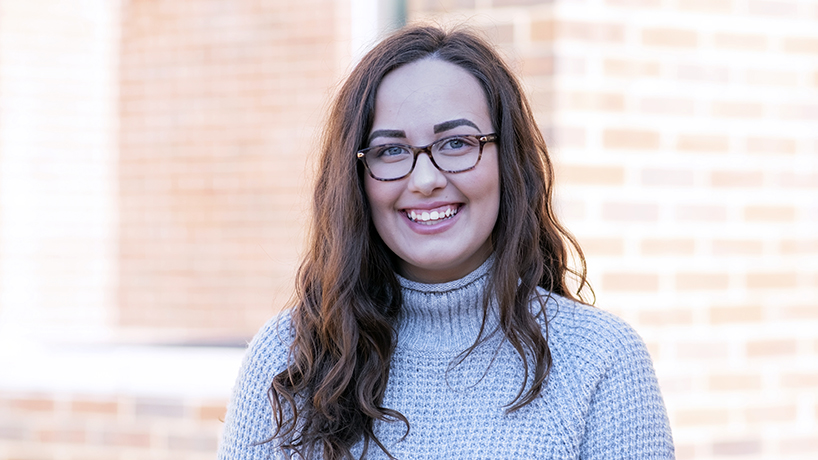
UMSL/WUSTL Joint Undergraduate Engineering Program and Honors College student Kearsten Sakamoto discovered she loves the problem-solving elements required in engineering while in school. (Photo by August Jennewein)
Kearsten Sakamoto knew that she wanted to be an optometrist.
So, when it came time to attend college, she chose to attend the University of Missouri–St. Louis figuring she could matriculate directly into the College of Optometry, and started studying chemistry.
Then her second semester of chemistry came around.
“I realized that I hated it,” Sakamoto said. “I had shadowed an optometrist, and I’m an extroverted introvert. I didn’t know that I could talk to patients all day, every day, for hours.”
Sakamoto dove into physics, math and engineering courses hoping to find a new direction. During a statics course with instructor Paul Groszewski, Sakamoto soon found herself enjoying the problem solving required – and even her engineering homework – and switched her major to civil engineering.
Now she’s in her third semester of the UMSL/Washington University in St. Louis Joint Undergraduate Engineering Program and is interning at Millstone Weber, helping on the I-270 North Design-Build. That’s a perfect fit because Sakamoto found her passion in transportation engineering and hopes to eventually address unequal food access.
In retrospect, it isn’t surprising to Sakamoto that engineering is a good fit. Her grandfather had been in school to be an engineer but dropped out when his wife became pregnant. Nonetheless, he stayed in the field, becoming a bridge inspector for the Missouri Department of Transportation.
“He passed away my freshman year, and I was really thinking about it,” she said. “He and I are very similar in a lot of ways. He’s very analytical and logical about everything. He always had the core samples of stuff that he was testing at work with him. When I decided engineering, I was like, ‘Well, I’m kind of just like him, I might be interested in that.’ I kind of got to thinking and I was like, ‘Alright, this sounds cool.’”
Adjusting to engineering coursework has been an interesting challenge for Sakamoto, who found herself needing a completely different approach than with her previous major.
“I had to program my brain to think and solve problems,” she said. “It’s a process to get yourself there. I don’t even think I’m there yet, honestly. Thinking like an engineer is hard, and it’s not natural. At first, I was like, ‘I can’t do it.’ But having to work at that is interesting and also challenging.”
Sakamoto hails from Hannibal, Missouri, and part of the reason she decided on UMSL was its urban setting, which ended up jiving well with a passion she’s discovered through engineering: transportation.
She first started on that path as an intern for MoDot. Then, taking a class with Vice President and Chief Operating Officer of CBB Transportation Engineers and Planners Shawn Leight opened her eyes to how transportation engineering encompasses not only safety and travel times but also poverty, city planning and access to medical facilities and food.
Sakamoto says that living in public housing in Cameron, Missouri, when she was younger made solving food deserts through transportation especially meaningful to her.
“If you live, say eight miles from your nearest grocery store, and you don’t have a car, you can’t afford a car, then how are you supposed to get food?” she said. “You can’t ride a bike to the grocery store, buy food for your family and then ride a bike back with a bunch of heavy bags. So you’re forced to go to a gas station and pay higher prices, which drives you even lower into poverty. You can make transportation accessible to everyone, in a public transportation sense, or in a sense where we can upgrade an area so that businesses want to come in and build there and allow people to have grocery stores walking distance from their homes.”
She’s getting a taste of what transportation design looks like through an internship with engineering firm Millstone Webber. As an unexpected bonus, her assignment to the 270-N project means she’s working closely with a variety of companies such as Parsons and CBB.
That’s a lucky break for her because the project has the potential to address the work she hopes to do long term.
“I am very interested because it is in North County, and it is a plan to better that area and get more businesses to move in,” she said. “I do find it really interesting to see all of it happen and read the proposals, and read all the reasons why this project is necessary.”
Leight has been something of a mentor, helping Sakamoto through learning the etiquette of the interview process in addition to being a good teacher. She’s also found solid support through Groszewski, her advisor.
That’s helped balance her engineering academics with her participation in the Pierre Laclede Honors College. The Honors classes, which are so different than those in the Joint Program, have helped round out Sakamoto’s experience.
One favorite was “Honors 2030: Inquiries in the Social and Behavioral Sciences” taught by Assistant Teaching Professor Christoph Schiessl.
“Our final research project, I did mine on Austrian neutrality in the Cold War,” she said. “I got really into it. I willfully spent hours upon hours on it.”
In part, Sakamoto’s education has been supported by an Honors College Merit Scholarship – as well as the Bright Flight, UMSL Curator’s and Chancellor’s Council scholarships – but neither the interesting classes nor the financial support have been the bright spot in her Honor’s College experience.
Sakamoto fell in love while in school and got married in August 2019.
“We were next door neighbors in Oak Hall,” she said. “We actually shared the wall between our rooms.”














